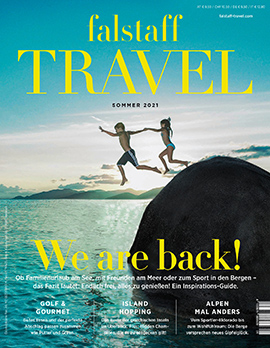
Why Hawaii Should Be on Your Bucket List
It’s not just 3,682 kilometers that separate the U.S. mainland from Hawaii’s 137 dreamy islands and atolls, but entire worlds: after all, here the principle of self-love and love for others is enshrined in law, surfing is a national pastime—and if you feel like it, you can send a decorated coconut instead of a postcard.
November 12, 2024
© Getty Images
“Aloha” greets you as soon as you land in Honolulu—it’s that Hawaiian word that has made its way into the global vocabulary, meaning so much more than just “hello.” “Aloha” conjures images of palm trees, sandy beaches, high waves, lush vegetation, and volcanoes. In fact, it’s used as both a greeting and a term for a way of life, embodying love, affection, understanding, farewell, compassion, and sympathy all at once. It’s an almost ubiquitous concept, one that has even made its way into Hawaiian law: the “Aloha Spirit Law” mandates treating oneself and others with respect and love. This extends to the flora and fauna of the island chain as well.
© Getty Images
And Hawaii truly has an abundance of nature to offer: mountain ranges overgrown with tropical plants, active and dormant volcanoes, black sand beaches, white sand beaches, and even green ones; the ocean, along with rivers and lakes, is home to an equally diverse array of fauna. Here, you can swim with sea turtles, watch geckos lick condensation from your beer glass, and wake up to the crowing of roosters. Hawaii was famously annexed by the U.S. in 1898 and became the 50th state in 1959—a fact that larger cities frequently remind you of, with neon signs for Walmart, Starbucks, and others. Fortunately, though, there's resistance in the state against mass tourism, homogenization, and the takeover of the islands by mainlanders looking for vacation homes and second residences. It’s only through this resistance that Hawaii’s rich Polynesian culture and the islands’ breathtaking nature can be preserved.
Hearty Hawaii
© provided
On all eight inhabited islands of Hawaii’s 137-island archipelago, it’s customary to greet one another with a hug rather than a handshake. People respect nature and share its gifts. So, if you find a box of ripe bananas by the roadside or in a hotel lobby, you’re welcome to take as much as you’d like to eat. And when entering a home, it’s second nature to take off your shoes—even if they’re Louboutins. One of the most cherished traditions is the “luau,” a celebration that brings friends and family together to dance, feast, and commemorate special moments in life. Besides numerous private luaus, there are also public ones across Hawaii, especially for tourists.
© provided
Of course, few of these are truly authentic—the often-featured fire dance actually originates from Samoa, and coconut shell bras were invented in Tahiti specifically for tourists. Genuine hula dances, on the other hand, are centuries-old rituals in which every hand movement carries its own meaning.
© provided
As similar as the traditions and culture may be across the eight inhabited islands, each one has its own unique character. A common rule of thumb is one week per island—so, if you don't have endless vacation time, it’s wise to plan a trip to Hawaii carefully.
Oahu: World famous thanks to Waikiki
© Mauritius Images
Oahu offers two standout features, making it an exciting destination: first, the island’s capital, Honolulu, is the largest city in the Pacific (and home to the international airport), and second, the Waikiki neighborhood is world-renowned for its white sand beach, turquoise waters, and hikes up to the Diamond Head Crater. Around what may be the oldest banyan tree in the world, the International Market Place has blossomed with chic designer boutiques from Balenciaga and Saks to Tesla. At night, life unfolds along the torch-lit streets of Waikiki. Just about 20 minutes from downtown, Hanauma Bay reveals an awe-inspiring underwater world, shaped by lava, waiting to be explored by snorkelers and divers alike.
Big Island, Kauai and Maui
© Unsplash
Big Island captivates with its contrasts: the south is rather barren, with endless lava fields creating a stark landscape, while the north boasts lush nature. Rising in the center of the island, Mauna Kea reaches 4,205 meters into the sky—a climb that’s well worth it, as the Milky Way displays its full splendor here. Be sure to dress warmly and start the journey early! Charming bars and restaurants await in Kailua-Kona, where the traditional Ironman competition kicks off each October. And for those looking to relax on a black sand beach with sea turtles, Punaluu is the place to be.
© Kauhale
Maui is slowly recovering after the devastating fires in the summer of 2023. While tourists are asked to act respectfully, official tourism authorities still encourage them to visit—the island relies on financial support for its rebuilding efforts. The fires completely destroyed Lahaina, once the center of tourism on the island; locals currently recommend going to nearby islands as an alternative.
© provided
For instance, you could go to Kauai: Known for its lush landscapes, it’s often called the “Garden Isle.” Those who want to hike through tropical terrain, watch dolphins, or walk in the footsteps of the Jurassic Park saga will find it perfect here. There are secluded beaches as well as popular ones, like Poipu Beach, where monk seals regularly take their afternoon naps. Along the Kuhio Highway, visitors are treated to a fascinating scene of red earth, dramatic coastlines, and misty island interiors; Nounou Forest invites hikers, while Maluhia Road offers a drive through a tree tunnel. You half-expect a dinosaur to emerge from the thicket at any moment. Instead, there are chickens everywhere—a kind of island mascot and, after all, distant relatives of the dinosaurs…
© Christian Horan Photography

This article appeared in the Falstaff TRAVEL issue Fall 2024.











